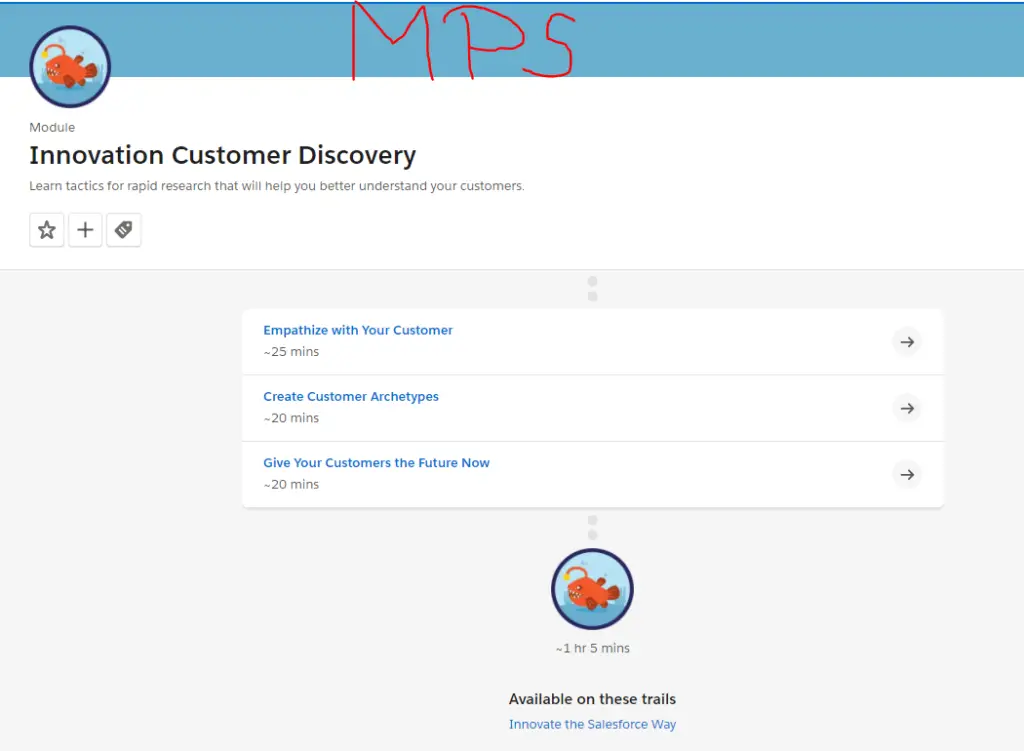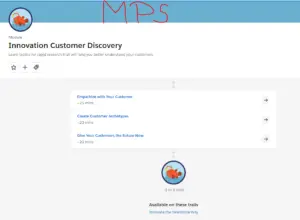In this article, we will discuss Innovation Customer Discovery and in the previous article, we discussed:

#1.Empathize with Your Customer
Q1)Why should you find ways to empathize with your customer through design research?
I)To convince your team that people care about your unconventional ideas
II)To truly understand your customer and judge if your solution will make a difference in their lives
III)To collect evidence that supports budget requests
IV)Because their lives are super interesting and you can live vicariously through them
[bg_collapse view=”button-green” color=”#4a4949″ expand_text=”Show Answers” collapse_text=”Hide Answers” ]
II)To truly understand your customer and judge if your solution will make a difference in their lives
[/bg_collapse]
Q2)What are three common forms of empathic research methods to gain deep insight into your customers?
I)Embodying, shadowing, and interviewing
II)Fishing, online research reports, and analyzing their social media accounts
III)Workshops, data mining, and interviewing
IV)Friending them on social media, online surveys, and trolling the dark web
[bg_collapse view=”button-green” color=”#4a4949″ expand_text=”Show Answers” collapse_text=”Hide Answers” ]
I)Embodying, shadowing, and interviewing
[/bg_collapse]
Q3)You should shadow someone to:
I)Study the person without having to get permission first
II)Map their digital presence
III)Develop empathy by helping them do their work
IV)Directly observe their behavior in person
[bg_collapse view=”button-green” color=”#4a4949″ expand_text=”Show Answers” collapse_text=”Hide Answers” ]
IV)Directly observe their behavior in person
[/bg_collapse]
#2.Create Customer Archetypes
Q1)What approach to synthesizing your research may reveal deep insight from your research?
I)Review diverse quotes and try to rewrite them as one quote that represents everyone
II)Go to dinner with a friend and role play your subjects to see how your friend reacts
III)List all the things that surprised you and analyze why you were surprised by them
IV)Seek out recurring themes, including pain points (discrepancies between people’s perceptions and their expressed reality)
[bg_collapse view=”button-green” color=”#4a4949″ expand_text=”Show Answers” collapse_text=”Hide Answers” ]
IV)Seek out recurring themes, including pain points (discrepancies between people’s perceptions and their expressed reality)
[/bg_collapse]
Q2)When capturing and clustering your notes always…
I)Capture and cluster alone first, then present to your colleagues for validation
II)Look for data that confirms or upsets your existing hypotheses
III)Enlist the help of your interviewees in the process
IV)Sort and discard anything that isn’t immediately useful
[bg_collapse view=”button-green” color=”#4a4949″ expand_text=”Show Answers” collapse_text=”Hide Answers” ]
II)Look for data that confirms or upsets your existing hypotheses
[/bg_collapse]
Q3)What is the core difference between archetypes and personas?
I)Personas have common household names, while archetypes have cool names
II)Archetypes describe characteristics of a user type, while personas express the personality of a market segment
III)Personas represent demographics, and archetypes represent behavior
IV)There is no difference—organizations use these terms interchangeably
[bg_collapse view=”button-green” color=”#4a4949″ expand_text=”Show Answers” collapse_text=”Hide Answers” ]
III)Personas represent demographics, and archetypes represent behavior
[/bg_collapse]
Q4)What is the core purpose of an archetype?
I)To represent behaviors and habits exhibited by a market segment throughout the design process
II)To tell stakeholders heroic stories about the opportunity with familiar fictional characters
III)To avoid leaving clues that might reveal the identity of the people you interviewed in confidence
IV)To summarize your findings into one powerful character that anyone can understand
[bg_collapse view=”button-green” color=”#4a4949″ expand_text=”Show Answers” collapse_text=”Hide Answers” ]
I)To represent behaviors and habits exhibited by a market segment throughout the design process
[/bg_collapse]
#3.Give Your Customers the Future Now
Q1)Which of the following is the best way to describe futurecasting?
I)Predicting the future
II)Envisioning the future we want to create
III)Fishing for future opportunities that will give us a competitive advantage
IV)Understanding the trajectory of the market and context for your innovation
[bg_collapse view=”button-green” color=”#4a4949″ expand_text=”Show Answers” collapse_text=”Hide Answers” ]
III)Fishing for future opportunities that will give us a competitive advantage
[/bg_collapse]
Q2)Why should you futurecast before you start ideating?
I)To avoid wasting time and resources if the problem won’t even exist in a few years
II)To future-proof your innovation work
III)To find new challenges to solve
IV)To ensure that you have credibility as thought-leaders
[bg_collapse view=”button-green” color=”#4a4949″ expand_text=”Show Answers” collapse_text=”Hide Answers” ]
II)To future-proof your innovation work
[/bg_collapse]
Q3)Which of the following is a good example of an activity that helps you futurecast?
I)Collect the latest weird and wacky cultural experiences in your city
II)Tweet predictions to see if people retweet them—or if the press picks them up
III)Create mockups of future products and experiences, then put them on an e-commerce site to see if anyone will buy them
IV)Attend Burning Man
[bg_collapse view=”button-green” color=”#4a4949″ expand_text=”Show Answers” collapse_text=”Hide Answers” ]
I)Collect the latest weird and wacky cultural experiences in your city
[/bg_collapse]
Q4)How will your futurecast impact your innovation process?
I)It will weed out the teammates who don’t share our vision for the future
II)It will manage the expectation that you will know the emerging trends even while you’re obsessively focused on today’s challenges
III)It will stretch your team to create a bolder and more relevant “How Might We” Quest to drive innovation
IV)It will find startups that the company should acquire that already have an amazing solution in this space
[bg_collapse view=”button-green” color=”#4a4949″ expand_text=”Show Answers” collapse_text=”Hide Answers” ]
III)It will stretch your team to create a bolder and more relevant “How Might We” Quest to drive innovation
[/bg_collapse]
FAQ:
What is an innovative customer?
A customer is the most important part of your business. Without them, you would not exist. It’s a fact that every business has to deal with, and yet, most of the time businesses are focused on everything but their customers. The best companies understand that they have to satisfy the needs and wants of their customers in order to succeed.
The real question is how do you know what your customers want? That’s where the innovative customer comes in. An innovative customer is someone who is always looking for something new and better. They don’t just want what you offer now, they want what you’ll offer next.
Innovative customers are your best source of new ideas and products. Innovative customers are the ones who will buy your new product, try it out, and then tell their friends about it. In what you’ll offer next.
Innovative customers are your best source of new ideas and products. Innovative customers are the ones who will buy your new product, try it out, and then tell their friends about it.
What is innovation in customer service?
Innovation in customer service is important for a business that wants to stay ahead of the competition. Here are three tips to help your company innovate and improve customer service.
1. Focus on the customer’s experience
2. Get creative
3. Test new ideas and improvements
Who are the innovator’s customers?
According to Christensen’s theories, disruptive innovation is the process by which a product or service takes root initially in simple applications at the bottom of a market and then relentlessly moves upmarket, eventually displacing established competitors.
This means that innovators’ customers are outliers. They do not pay attention to what other people in their social circle are doing, and they are very opinionated. Innovator’s customers are usually your best source for feedback, though some of them have such strong personalities that you have to be careful about how you relay their opinions.
What are the 4 phases of customer discovery?
The customer discovery process can be broken down into four phases. These four phases are important because they give you a clear idea of what your potential customers are looking for and how you can reach them.
# Define the Problem
You need to understand why your customers have a problem, because if you don’t, then you won’t be able to solve it. You should also understand the issues that led them to have a problem in the first place, as well as their current solution for that issue.
# Define the Segments
Once you know some of the problems that your audience is facing, you need to find out who they are. You can do this by identifying the segments of your audience that have a problem and then understanding what makes them different from each other.
# Define the Customer Journey
You need to understand the customer journey, which is the path that your customers take from first encountering a problem to solving it. You should identify the steps in this journey and then determine how you can help them move through it.
# Define the Channels
You need to identify the channels that you can use to reach your audience. You should determine how they are different from each other and what they offer your customers.
What is the goal of customer discovery?
The goal of customer discovery is to learn everything about the potential customers, their needs, problems, and goals. It’s important to make sure that you understand what they want and what they don’t want before you start working on a solution. And the only way to do that is by asking the right questions.
There are two basic questions you must ask in your customer discovery:
1) What is the problem?
2) Why are they having this problem?
How do we practice innovation customer discovery?
Customer discovery is a fundamental part of any startup. It’s essential to understand whether you have a viable product and who your target audience is.
It helps you focus on your customers, and build products they actually need. Good customer discovery leads to successful businesses, so it’s no surprise that the best startups are constantly practicing customer discovery.
Here are 5 ways to practice customer discovery in your startup:
- Do market research with surveys and polls. See what people say about the problem you’re solving for them. How do they describe it? What language do they use
- Conduct interviews – ask customers questions directly in order to get deeper insight into needs and problems
- Use competitor analysis – monitor competitors’ marketing strategies and see who they are targeting (this will help you find potential customers)
- Use customer segmentation – this is a very useful tool for startups that want to get the most out of their marketing efforts. It helps you focus on the right audience and communicate with them in the right way.
- Use your own experience – as a founder, you are the best source of information about your customers. You know their problems and needs because you are one of them.
